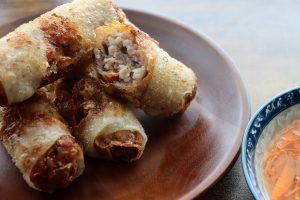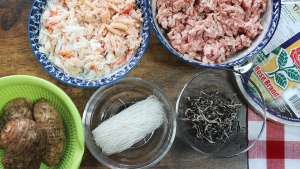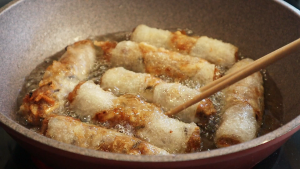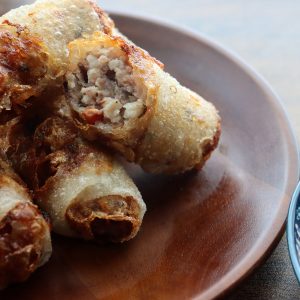Chả Giò (Vietnamese Spring Roll)

Besides Phở, Chả Giò (or spring roll) is likely the second most well-known Vietnamese dish. The fillings for Chả Giò typically include minced pork, shrimp, mushrooms, vermicelli noodles, and various vegetables like carrots, taro, or jicama. The mixture is seasoned with fish sauce, garlic, and other spices before being wrapped in either rice paper or wheat-based wrappers.
The name “Chả Giò” is how people in southern Vietnam refer to “spring roll,” while in the North, they are called “Nem Rán.” There are different theories about the origin of Chả Giò. One theory suggests it originated in China, while another claims that the dish was introduced to southern Vietnam and later promoted in the North by a French woman, eventually spreading across the country. However, I believe that Chả Giò originally comes from the North.
Chả Giò is a popular dish for special occasions such as the Lunar New Year (Tết) and family gatherings. The process of making Chả Giò is often a shared family activity – imagine the mother preparing the fillings, the daughter doing the rolling, and the aunt frying the rolls. It’s a dish that brings the women of the family together.
Is Chả Giò a healthy dish? I’d like to think so. Even though the rolls are deep-fried, they are usually served with an assortment of fresh vegetables like lettuce and various aromatic herbs, creating a nicely balanced dish.
Here are a few notes on my Chả Giò recipe:
- I use rice paper for wrapping. I prefer this traditional approach because the rolls wrapped in rice paper become crunchier and tastier when deep-fried compared to those wrapped in wheat-based paper.
- Instead of jicama, I use taro in the fillings.
- I use minced pork and crab meat as the main proteins. While crab meat might be more expensive than shrimp, I believe it enhances the flavour of the filling.
Q&As on Chả Giò
1. What is the difference between Chả Giò and other types of spring rolls?
Chả Giò is a Vietnamese fried spring roll, typically filled with a mixture of minced pork, shrimp, vegetables, and sometimes noodles. It’s usually wrapped in rice paper or wheat-based wrappers and then deep-fried until crispy. Other types of spring rolls, like the Chinese egg roll or the Thai spring roll, might use different fillings, seasonings, and wrappers. For example, Chinese egg rolls are often larger, with thicker, wheat-based wrappers, and might include cabbage and other vegetables. Thai spring rolls might be smaller, with a lighter filling and a thinner, rice-based wrapper.

2. Are the ingredients for Chả Giò easy to find?
Yes, most of the ingredients for Chả Giò are relatively easy to find, especially if you have access to an Asian grocery store. Common ingredients like ground pork, shrimp, taro, and vegetables are widely available. Specialty items like rice paper, wood ear mushrooms, and dried bean vermicelli might be found in the international or Asian food aisle of larger supermarkets. If certain ingredients are hard to find, they can often be substituted with more readily available options without compromising the overall taste.
3. How long does it generally take to make Chả Giò?
The process of making Chả Giò typically takes about 1 to 2 hours, depending on your level of experience and how many spring rolls you’re preparing. The time includes soaking and preparing the ingredients, mixing the filling, rolling the spring rolls, and frying them until golden and crispy. While the process can be somewhat time-consuming, it’s straightforward and can be made more efficient by preparing some ingredients in advance.

4. What are the differences between rice paper and wheat-based wrappers in making Chả Giò?
The choice between rice paper and wheat-based wrappers can affect both the texture and flavour of Chả Giò.
Rice paper is the traditional choice in Vietnam, offering a delicate, crispy texture when fried. It has a slightly chewy interior that contrasts nicely with the crispy exterior.
Wheat-based wrappers, on the other hand, are thicker and tend to produce a more uniformly crispy roll with a slightly different texture, often seen in Chinese-style egg rolls. The flavour of wheat-based wrappers is more neutral, while rice paper has a subtle rice flavour that complements the filling.
Both options can be delicious, but rice paper is generally preferred for an authentic Vietnamese Chả Giò experience.
5. How do you eat Chả Giò?
Chả Giò is typically eaten by wrapping each fried roll in a lettuce leaf along with fresh herbs like mint or basil. It’s then dipped in a tangy dipping sauce called nước chấm, made from fish sauce, lime juice, sugar, garlic, and chili. This combination of crispy, fresh, and tangy elements creates a harmonious balance of flavours and textures.
6. Can Chả Giò be made vegetarian or vegan?
Yes, Chả Giò can be made vegetarian or vegan. The meat and seafood in the filling can be replaced with a variety of vegetables, tofu, or mushrooms. Popular vegetarian fillings include carrots, taro, jicama, mushrooms, and vermicelli noodles. The rice paper wrappers used in traditional Chả Giò are typically vegan, but it’s always good to check the ingredients if you’re unsure.
7. Why does Chả Giò sometimes have a different name in different regions of Vietnam?
In Vietnam, the name for Chả Giò can vary by region due to cultural and linguistic differences. In the southern part of Vietnam, it is commonly called “Chả Giò,” while in the northern regions, it is referred to as “Nem Rán.” Despite the different names, the dish is essentially the same, though the filling might vary slightly depending on local ingredients and preferences.
8. How do you keep Chả Giò crispy after frying?
To keep Chả Giò crispy after frying, it’s important to drain them well on a wire rack or paper towels to remove excess oil. If you need to store them for later, allow them to cool completely before storing them in an airtight container. When ready to serve, you can reheat them in an oven or air fryer at a low temperature to restore their crispiness. Avoid covering them with a lid while they are still hot, as the trapped steam can make them soggy.

9. Is Chả Giò an appetizer or a main dish?
Chả Giò is traditionally served as an appetizer in Vietnamese cuisine, often as a starter to a larger meal. It’s commonly enjoyed on its own or alongside fresh herbs, lettuce, and a dipping sauce like nước chấm. However, Chả Giò can also be part of a main dish, especially when served with rice, vermicelli noodles, or as a component of a larger platter with various accompaniments. The versatility of Chả Giò allows it to be enjoyed in different ways, depending on the occasion and the preferences of the diners.
10. How do you pronounce “Chả Giò?”
“Chả”: Pronounced like “chah,” with a soft “ch” sound, like the “ch” in “charm.” The vowel sound is like “ah,” as in “father.” The tone is a bit falling, almost like a gentle dip in pitch.
“Giò”: Pronounced like “yaw,” with a soft “y” sound, like the “y” in “yes.” The vowel is pronounced like “aw” in “saw.” The tone is slightly rising, so your voice should go up a bit at the end.
When saying “Chả Giò,” try to keep the pronunciation smooth, without stressing any syllable too heavily. The tones in Vietnamese are subtle but important, so paying attention to the pitch changes will help with an accurate pronunciation.

Recipe for Chả Giò (Vietnamese Spring Roll)
Equipment
- Large, deep frying pan or wok
Ingredients
- 2 pounds ground pork
- 500 grams crab meat
- 4 taro roots
- Dried wood ear mushrooms
- Dried bean vermicelli
- Rice paper
- For seasoning: Salt, ground black pepper, MSG (or chicken bouillon powder)
Instructions
- Preparation of Chả Giò fillingsPlace the dried wood ear mushrooms and dried bean vermicelli in separate bowls. Pour enough water over them to fully submerge them. Let them soak for about 15-20 minutes, or until they become soft and pliable.
- Carefully peel the taro roots using a vegetable peeler or a sharp knife to remove the outer skin. Rinse the peeled taro roots under cold water to remove any residual dirt or starch. Next, use a sharp knife to slice the taro into thin, matchstick-like strands.
- Once the bean vermicelli has softened, drain it in a colander to remove excess water. Place the vermicelli on a cutting board and use kitchen scissors or a knife to cut it into shorter strands, about 1 inch in length.
- After the wood ear mushrooms have softened, drain them well and gently squeeze out any excess water. Place the mushrooms on a cutting board and use a sharp knife to chop them into finer pieces, aiming for a small, even dice.
- In a large mixing bowl, combine the ground pork and crab meat, breaking them up with your hands or a spoon to ensure they are well-mixed. Add the prepared taro strands, chopped wood ear mushrooms, and sliced bean vermicelli to the bowl. If you like, you can also add finely ground shallots for extra flavour. Mix everything together thoroughly until all the ingredients are evenly distributed.
- Sprinkle the mixture with salt, pepper, and a small amount of MSG (if using), adjusting the seasoning to taste. Mix everything together until the seasonings are evenly incorporated. The filling should be well-blended, with all the ingredients evenly coated in the seasoning, and ready to be wrapped in the chả giò.
- Rolling Chả GiòTake a single sheet of rice paper and briefly dip it into a bowl of warm water, ensuring that it is fully submerged. Let the excess water drip off, and then carefully lay the rice paper flat on a clean surface, such as a cutting board. The rice paper will soften and become more pliable as it sits, making it easier to roll without tearing.
- Spoon a small portion of the prepared filling, about 2 tablespoons, onto the lower third of the rice paper, near the edge closest to you. Shape the filling into a compact log, leaving some space on either side to fold in the edges. Begin rolling the rice paper away from you, tucking the filling snugly as you go. After making the first roll, fold in the sides of the rice paper over the filling, then continue rolling tightly until you reach the end, creating a neat, sealed roll.
- Frying Chả GiòSelect a large, deep frying pan or wok and pour in enough cooking oil to submerge at least half of the spring rolls during frying. Heat the oil over medium-high heat until it reaches the proper frying temperature.
- Carefully place the prepared spring rolls into the hot oil, making sure not to overcrowd the pan. Depending on the size of your pan, you may need to fry them in batches. Let the spring rolls cook for a few minutes on one side until they start to turn golden brown, then use tongs or a slotted spoon to gently turn them, ensuring that all sides cook evenly. Continue frying until the spring rolls are uniformly golden and crispy.
- When the spring rolls are fully cooked, use a slotted spoon or tongs to remove them from the oil and place them on a plate lined with paper towels to drain any excess oil. Allow them to cool slightly, just enough to handle.
- Chả Giò is now ready to be served!Serve the golden, crispy spring rolls immediately while they're still hot and crunchy. They are traditionally served with a dipping sauce made from fish sauce, lime juice, sugar, garlic, and chili, which complements the rich flavours of the chả giò perfectly.

